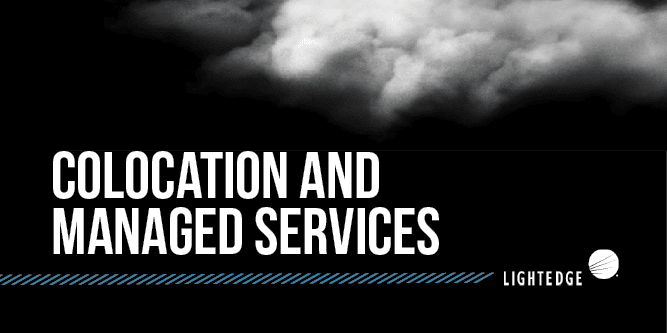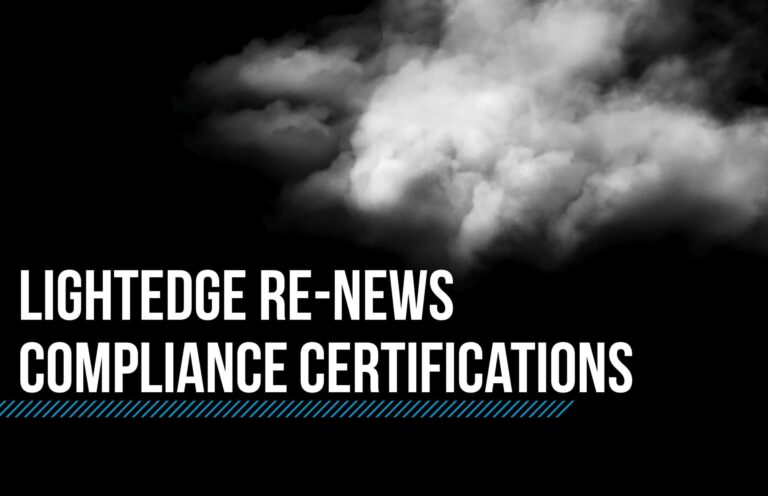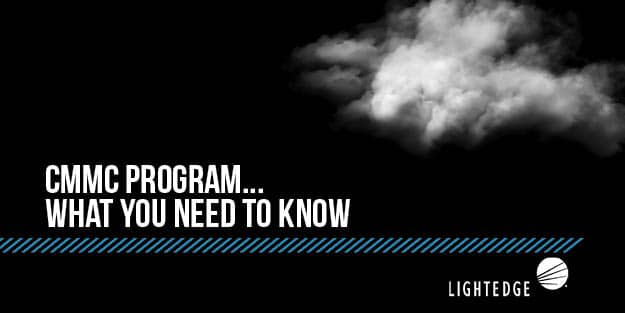How NIST 800-53 Maps to FedRAMP
October 22, 2020

Lightedge
Author

It’s no secret that the last six months have been full of adaptation as companies have pivoted to a mostly-remote workforce. Given that level of coordination, it’s obvious the cloud has become essential to continue operating with business as usual. But with heightened reliance on the cloud, it can be anxiety-inducing to think about all the potential security pitfalls that come with it, especially if you do any work on federal projects.
If your brain is buzzing with nightmarish scenarios of data breaches, security threats, and identity theft, you’re not alone. But no need to worry if you picked a high-compliance cloud provider that abides by FISMA regulations. They have your company’s and your clients’ information locked down and adhere to a strict set of requirements when it comes to protecting your data. That’s where FedRAMP and NIST 800-53 come into play.
In today’s post, we’ll take a deep dive into NIST 800-53 and how it can help you on your way to a FedRAMP authorization. It’s important to see how all the moving parts work together, as well as, imperative to understand what’s expected of a cloud provider in order to gain the authorization for those business-building government contracts.
Where it all Began
While we’ve been living in the age of the internet for a while now, it’s no secret that a handful of organizations still need a little help catching up with the demands of modern cybersecurity protocol and information protection. Government contractors are no exception. In fact, they are often some of the organizations most at risk for security breaches or other sinister activity, simply because of the nature of their clients.
The Federal Information Security Modernization Act of 2014 (FISMA) was instated to update all of the federal government’s cybersecurity practices for its cloud providers in light of rising cybersecurity concerns. FISMA’s goal is to ensure cloud service providers offer the highest level of security, mobility, and flexibility to their customers. All of which are especially important during times like these where we see higher instances of employees working from the comfort of their homes.
FISMA-compliant vendors receive ATO (Authority to Operate) from only the singular federal agency through which they are contracted. Once they get ATO for one agency, they do not automatically gain ATO for other agencies as specific data needs may necessitate different security controls.
Some organizations are looking for opportunities to gain authorization for multiple agencies without having to go through multiple FISMA authorizations. What FedRAMP ultimately accomplishes is a fast-track to ATO from multiple agencies by establishing a strong framework of compliance regulations for companies to follow.
It’s important to note that FISMA and FedRAMP are similar authorizations that are not actually related or dependent on one another. FedRAMP is the more expensive option but it’s only necessary to complete it once. With FISMA, you may spend less money on the front end but then have to repeat the process multiple times.
FedRAMP vs NIST 800-53
While both FedRAMP and NIST 800-53 are crucial frameworks for federal contractors, it’s important to understand the key differences between the two and identify which requirements you really need these to map to for your unique business.
FedRAMP
The US Government requires its cloud service providers to adhere to a strict set of guidelines in order to continue with their contracts. FedRAMP offers a multitude of training modules, as well as, a path to a FedRAMP authorization for cloud service providers interested in partnering with the federal government. The process of getting a FedRAMP authorization includes the following steps:
- Pre-Authorization with an emphasis on education and relationship building, while installing the required controls for authorization
- Authorization where a security package is itemized and implemented
- Post-Authorization, which is all about accountability
- The cloud service provider has to provide monthly deliverables to the agency utilizing their services
The good news is that, once a company gains the FedRAMP authorization, it is fairly simple to remain compliant as their authorization notes stay in the database for future evaluations. This initial authorization can be built upon or tweaked as compliance requirements change over time. Cloud service providers can continue to add layers to their security to remain compliant as ever.
NIST 800-53
NIST 800-53 is a communication issued by the National Institute of Standards and Technology (NIST) and can be leveraged by organizations who want to get closer to achieving FISMA. While FedRAMP is designed for providers working with federal agencies, NIST 800-53 can be used as a framework for any industry, given its broad scope of security controls. NIST is considered the gold standard for all elements of compliance from manufacturing to the end user.
NIST 800-53 may not be required by name as part of the FISMA ATO process, but leveraging NIST 800-53 can get you closer to your compliance goals. Because NIST 800-53 is so all-encompassing, implementing its controls and adhering to its recommendations will help you tremendously.
By complying with NIST 800-53, your organization will not only be well on its way to FISMA and FedRAMP compliance, but it will also improve multiple other areas of compliance including, HIPAA and PCI DSS, making it appealing across many industries. For the long-term security of your organization’s data, no matter which customers you serve, the decision to work toward NIST 800-53 is an easy one.
How NIST 800-53 Works with FedRAMP
FedRAMP and NIST 800-53 work together in a bit of a dance and it’s important to understand how they both get you closer to achieving your goal of a federal contract or higher levels of compliance.
Start with NIST 800-53
Being NIST 800-53 compliant doesn’t automatically guarantee a FISMA ATO or FedRAMP authorization, but it is a great stepping stone toward a FISMA authorization. If your organization is following the security recommendations laid out in NIST 800-53, you and your team will ultimately do less work preparing for a FISMA authorization. NIST 800-53 is primarily concerned with system, platform, and organization-related considerations, so you can check them off the list as you prepare to tackle a valuable federal authorization.
Crucial Elements of NIST 800-53
NIST 800-53 outlines key activities for policy creation, oversight, communication, and defining controls, which act as safeguards to maintain the integrity and security of your systems. Through the development of these controls, it’s important to keep in mind that there are over a dozen control families outlined in NIST 800-53 for a total of 956 controls. If it seems overwhelming, that’s because it is. But the good news is that many of these controls are pretty basic and can easily be checked off the list as your organization might already be using them without knowing that they are NIST 800-53-specific. That said, here are a few things you should make a priority as you strive for compliance:
- Discover and Classify Sensitive Data: Make sure everyone on the team is crystal clear on your company’s policy for the classification of data. Take the necessary steps to secure all sensitive data. Map out who has what access and identify groups, users and permissions that need to be put in place.
- Monitor Data and File Activity: Constant vigilance is vital to your company’s information security. Always be on the lookout for suspicious activity within your storage. This could take on several forms, from malware to security breaches to accidental human error. If you implement a control to monitor security, you can catch these problems before they become unmanageable.
- Manage Access Control: Do you know who has access to which information? This is key to protecting data from insider threats, like dishonest employees. Make sure there is a database outlining exactly which team members can access each bit of information at every level of classification. Update this list regularly to remove former employees and implement a least-privilege model. Routinely monitor the activity of all employees and watch for anomalies when it comes to accessing information.
Your Provider May Hold the Key
If you’re looking at choosing a cloud provider, rather than storing your own data, you’re not alone. Many companies are choosing to go this route, as building their own data center facilities can be time-consuming, expensive, and downright impossible. According to digital.gov, Getting your FedRAMP authorization process can be a costly endeavor. The median cost for a mid-range CSP was over $2 million.
Choosing to outsource to a cloud provider has the potential to be a blessing and a curse, since you may lose some of the direct control over security and privacy that you need to meet compliance requirements, but they can also offload a lot of responsibility in terms of compliance controls. The right cloud service provider can make your organization’s road to FISMA authorization smooth, efficient, and relatively painless.
Savvy organizations ask for NIST 800-53 compliance from their cloud providers because they know how valuable it is to have those steps handled and out of the way so you can put more focus on other elements of compliance certifications, whether it’s FedRAMP, FISMA, or another, like HIPAA or HITRUST.
Red Flags When Choosing a Cloud Provider
So you’ve decided to search for a cloud provider. With a sea of options in front of you, it can be hard to decide which one best meets your organization’s needs, especially when everyone is putting their best foot forward to land the sale. Here are a few things that should absolutely be deal breakers and have the potential to lose you that coveted federal contract.
1. Certifications Matter
Many cloud service providers can, by nature of the cloud, transfer some of their certifications onto their customers. Since many certifications have to do with cloud data security, if they are certified, you are certified. If your provider cannot or does not have transferrable certifications, this can cause a lot of headaches when it comes time for a compliance review or an attempt at FedRAMP authorization. Attaining documentation from your compliant cloud provider shouldn’t be a headache, and the right provider will be more than willing to work with you in order to get your compliance documentation in order, including proof of their own certifications.
2. Physical Issues
If at all possible, go on a tour of the data center during the sales process. Take a look at the physical security measures, including controlled entry, multi-factor authorization, and the security of the specific area where your data would be stored. If anything seems amiss here, it’s time to walk away. It’s also important to think of the location of your data center. If your facility is in an area that is likely to be impacted by natural disasters or extreme weather, think through the risks of outages or physical damage to the structure of the building. Certain physical security or integrity issues can also cost cloud providers valuable certifications.
3. Poor Failover Rates
Think about redundancy when shopping for providers. How many networks does your provider incorporate into their services? Especially if their data center is in an area with a higher risk of inclement weather or natural disasters, it is crucial that they have plans in place to switch from one provider to another—and quickly. This switch, also known as failover, is key to a successful cloud that’s always on and always secure for you and your customers’ data. If a provider doesn’t have a good failover rate, it’s definitely time to think about looking elsewhere.
If you find a cloud provider that doesn’t raise alarm bells and is able to prove their NIST compliance, you are likely in good hands. If you choose to partner with them for your storage solutions, you’ll likely find that your path to FedRAMP authorization will be much smoother than those who did not.
Lightedge Leads the Pack in Compliance
If you’re searching for a compliant cloud provider to help you in your journey to FedRAMP authorization, Lightedge may be for you. Lightedge’s seven data centers controls are specifically designed to meet a wide spectrum of U.S regulatory requirements including NIST 800-53. We are able to work with customers as they seek compliance with FISMA and FedRAMP with our secure, compliant data centers.
At Lightedge, we are constantly raising the bar when it comes to compliance. Lightedge goes above and beyond for our customers by meeting the highest standards for security and privacy. By achieving NIST 800-53, Lightedge demonstrates our ongoing commitment to excellence by giving our customers’ most critical data the protection it deserves.
Lightedge is also proud to offer customers Compliance as a service. Compliance as a service can be a great way to get your business well down the road to being compliant, but make sure you are aware of your provider’s services and what you need to do to ensure your data is protected and compliant. Contact us today to get the ball rolling on tailored solutions for your security and compliance needs.


